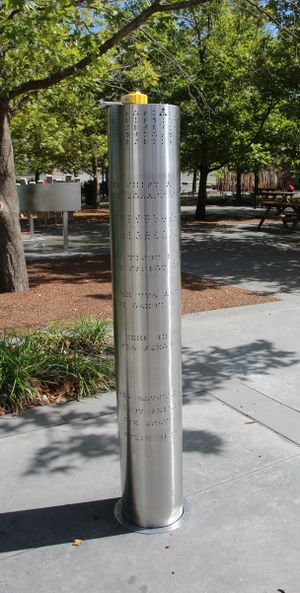Difference between revisions of "Pillar 7"
(→Transposition (Caesar) cipher) |
|||
| Line 8: | Line 8: | ||
At the top of the pillar is a grid of numbers of 5 rows and 26 columns. A triangular glyph surrounds a number (rather than pointing as in other pillars). | At the top of the pillar is a grid of numbers of 5 rows and 26 columns. A triangular glyph surrounds a number (rather than pointing as in other pillars). | ||
{|border="1" | {|border="1" | ||
| − | | | + | |<tt> |
3524861491635354710149097'''4''' | 3524861491635354710149097'''4''' | ||
| Line 18: | Line 18: | ||
81491040353180149092635377 | 81491040353180149092635377 | ||
| + | </tt> | ||
|} | |} | ||
| Line 25: | Line 26: | ||
At the top is a plaintext which makes an obvious reference to Caesar: | At the top is a plaintext which makes an obvious reference to Caesar: | ||
{|border="1" | {|border="1" | ||
| − | |A LETTER SHIFT A CIPHER MAKES | + | |<tt> |
| + | A LETTER SHIFT A CIPHER MAKES | ||
A FAMOUS ROMANS NAME IT TAKES | A FAMOUS ROMANS NAME IT TAKES | ||
| + | </tt> | ||
|} | |} | ||
| Line 34: | Line 37: | ||
{|border="1" | {|border="1" | ||
| − | | | + | |<tt> |
B MFUUFS TIJGU B DJQIFS NBLFT | B MFUUFS TIJGU B DJQIFS NBLFT | ||
| Line 57: | Line 60: | ||
XVZIZ GBHV ERIQIF | XVZIZ GBHV ERIQIF | ||
| + | </tt> | ||
|} | |} | ||
Using a [http://planetcalc.com/1434/ simple online Caeser cipher calculator], this decrypts using various shifts to read | Using a [http://planetcalc.com/1434/ simple online Caeser cipher calculator], this decrypts using various shifts to read | ||
{|border="1" | {|border="1" | ||
| − | | | + | |<tt> |
(With a shift of 1) | (With a shift of 1) | ||
| Line 81: | Line 85: | ||
A KUFA MAN COULD FIND THEM OUT | A KUFA MAN COULD FIND THEM OUT | ||
| − | + | </tt> | |
|} | |} | ||
| Line 92: | Line 96: | ||
{|border="1" | {|border="1" | ||
| − | | | + | |<tt> |
(Using the Vigenere cipher with a key of "vigenere"): | (Using the Vigenere cipher with a key of "vigenere"): | ||
| Line 104: | Line 108: | ||
GREAT CODE AWAKES | GREAT CODE AWAKES | ||
| + | </tt> | ||
|} | |} | ||
| Line 109: | Line 114: | ||
A string of numbers runs around the base. | A string of numbers runs around the base. | ||
{|border="1" | {|border="1" | ||
| − | | | + | |<tt> |
10 11 9 11 9 12 13 17 28 29 15 17 11 12 11 12 11 13 20 24 9 13 11 11 7 93 11 11 14 17 | 10 11 9 11 9 12 13 17 28 29 15 17 11 12 11 12 11 13 20 24 9 13 11 11 7 93 11 11 14 17 | ||
| − | |} | + | </tt>|} |
Revision as of 22:03, 9 March 2013
Pillar 7 is the shortest pillar. It also explains the method it uses to encrypt the alphabetic text. It is presumably a pillar to introduce participants to the concepts of encryption.
It contains an unexplained numerical grid near the top of the pillar.
Numerical Grid
At the top of the pillar is a grid of numbers of 5 rows and 26 columns. A triangular glyph surrounds a number (rather than pointing as in other pillars).
|
35248614916353547101490974 24725391509414892533731941 14909573522681490367353636 41635353213194116435346709 81491040353180149092635377 |
Transposition (Caesar) cipher
The remainder of the pillar is filled with a simple cipher - the Caesar cipher.
At the top is a plaintext which makes an obvious reference to Caesar:
|
A LETTER SHIFT A CIPHER MAKES A FAMOUS ROMANS NAME IT TAKES |
Then below that, it pictorially depicts a letter shift. In this example, A>B, B>C, C>D and so on, with Z>A.
Below this is a cipher text:
|
B MFUUFS TIJGU B DJQIFS NBLFT B GBNPVT SPNBOT OBNF JU UBLFT
DWV QVJGT OQXGU C EQFG ECP OCMG
D NXID PDQ FRXOG ILQG WKHP RXW
INGY PZBZIE XROZA OPK RNQV SA ENMPL XVZIZ GBHV ERIQIF |
Using a simple online Caeser cipher calculator, this decrypts using various shifts to read
|
(With a shift of 1) A LETTER SHIFT A CIPHER MAKES A FAMOUS ROMANS NAME IT TAKES
A SHIFT OF TWO YOU NOW CAN BREAK BUT OTHER MOVES A CODE CAN MAKE
HOWEVER THEY BE SWAPPED ABOUT A KUFA MAN COULD FIND THEM OUT |
The presence of the word "KUFA" is strange, but I confirmed that NXID appears in the cipher text.
The final four lines resist any number of simple shifts. It is possible that it is encoded using something like a Vigenere cipher.
An analysis using an online Vigenere breaking tool conducts frequency analysis to try to determine a key. It responds with a lot that start with "VIG", leading me to guess "VIGENERE".
|
(Using the Vigenere cipher with a key of "vigenere"): WHEN DIFFERENT SHIFTS EACH LETTER TAKES (and resetting at the end of the two lines) THE NAME OF WHICH GREAT CODE AWAKES |
Base
A string of numbers runs around the base.
|
10 11 9 11 9 12 13 17 28 29 15 17 11 12 11 12 11 13 20 24 9 13 11 11 7 93 11 11 14 17 |} |

